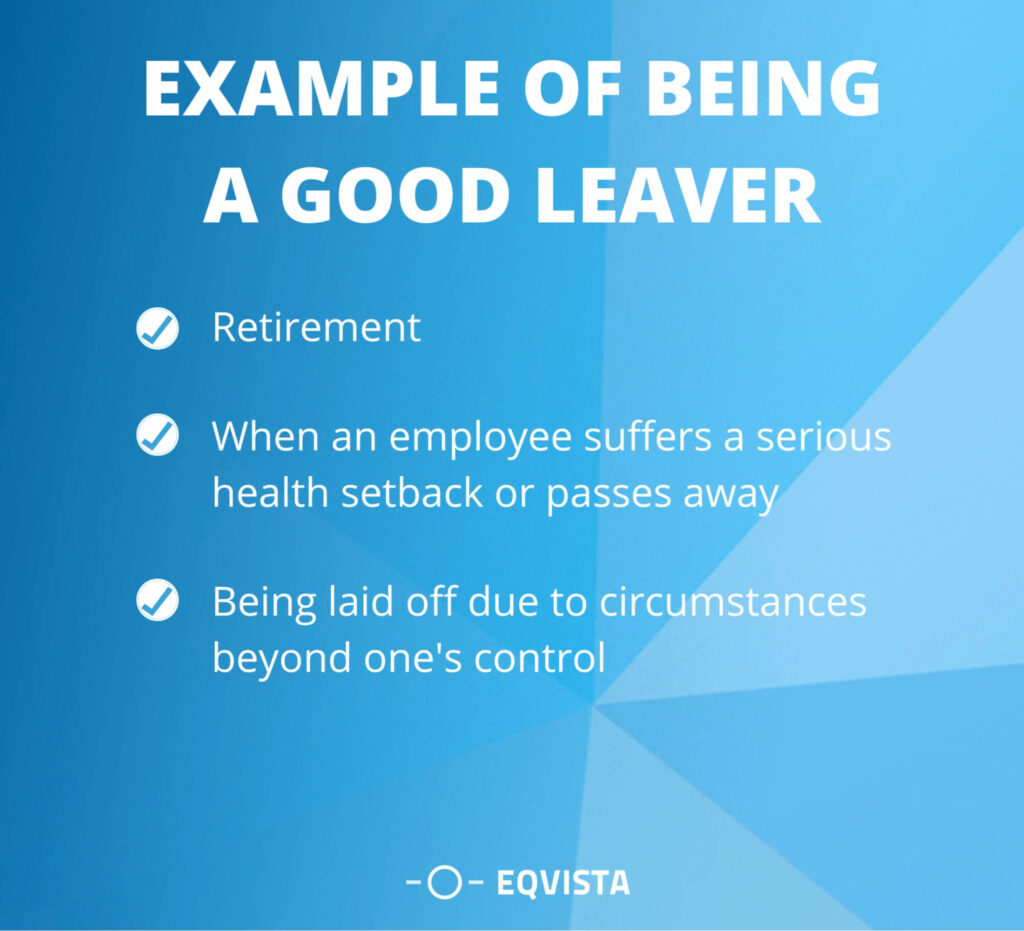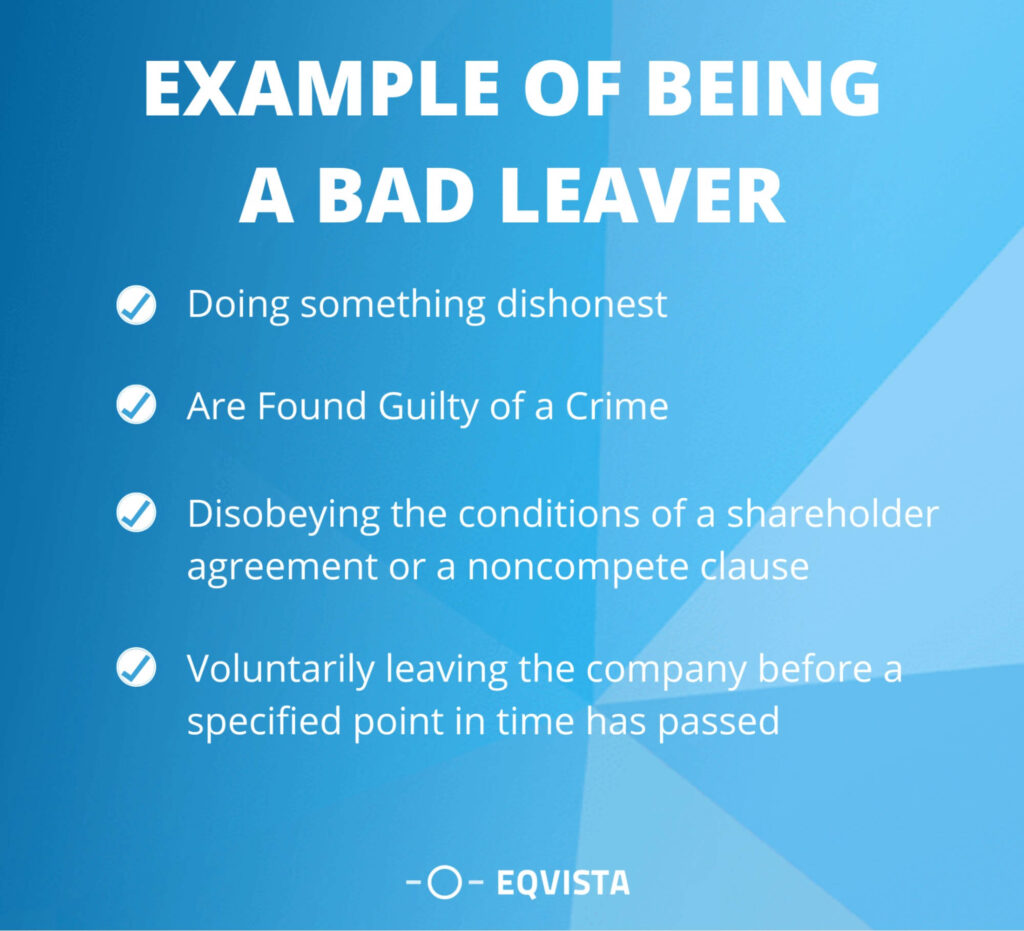Good Leaver vs Bad Leaver: Key Differences and How They Impact Company Culture
This article will help you understand the key differences between good and bad leavers and the benefits of having good leavers for the company culture.
You may not immediately give much thought to your exit strategy after receiving stock options from your employer. But if you fast-forward a few years, the leaver clause in your employment agreement suddenly becomes crucial when you decide to leave. How do others see you after you leave? Many businesses alter their basic articles to include clauses requiring transfers. If the leaver is seen as a “good leaver” or a “bad leaver,” they often apply different regulations and share prices.
In any investment contract, the good leaver/bad leaver stipulations are sometimes one of the hardest to negotiate. This article will help you understand the key differences between good and bad leavers and the benefits of having good leavers for the company culture.
Good and bad leavers in a company
When a director-shareholder (or any employee owning shares) leaves their position, the conditions of their departure might be classified as “good leaver” or “bad leaver” depending on the circumstances.
They ensure that all shareholders have identical exit strategies by connecting continued employment with financial benefits from holding shares and tying the end of ownership to the termination of work (whether voluntary or by dismissal).
Shareholding rights are distinct from employment rights. Those protections may be rolled into one by including “good leaver” and “bad leaver” provisions in employment contracts.
Importance of understanding the differences between them for company culture
How should stock be handled when an employee resigns from a company? There are situations in which a leaving director’s retention of stock options is supported by the company’s shareholders.
The question for the surviving shareholders is why former employees should benefit from the company’s future success when they had no part in bringing it about. What’s more, if you fire an employee for bad performance or misbehavior, do you want them to keep their stock and the income and rights to vote that come with it?
That’s when your leaver benefits begin to take effect. They are mandatory transfer provisions in an agreement with shareholders or articles of association that require a departing director or employee to sell his shares to the remaining shareholders or the firm for an agreed price.
Who is a Good Leaver?
One purpose of a good leaver provision is to incentivize a valuable worker to remain on the payroll for an extended period or until a certain objective is met.
In contrast to incentives like stock options or vesting provisions, the individual will already have all the rights and responsibilities that come with being a shareholder.
The reward is the unrestricted continuance of ownership following an event or just the retention of ownership if the employee departs the company under “good” circumstances.
Definition and characteristics of a good leaver
The termination of an employee’s employment for circumstances outside their reasonable control, such as sickness or redundancy, is usually covered by a good leaver provision. The employee may be entitled to a part of their salary or be allowed to retain corporate property under the terms of the clause.
The contractual agreement between an employer and employee is the usual mechanism for enforcing a fair severance policy. The terms of an employee’s departure, including whether or not they qualify as a “good leaver,” will be laid out in the contract.
Examples of being a good leaver
Businesses are free to set their standards for what constitutes a good or terrible departure, sometimes with the help of outside counsel. Typical scenarios when an employee is considered a “good leaver” and allowed to keep their matured share options while leaving the company are:

- Retirement
- When an employee suffers a serious health setback or passes away (in which case, his or her stock options would be distributed to heirs)
- Being laid off due to circumstances beyond one’s control, such as a merger or the elimination of a position
Benefits of having good leavers for the company culture
Having workers who leave on good terms, or “good leavers,” may be beneficial to a company’s culture in several ways. Some examples:
- Successful ex-employees are more inclined to brag about their time with the firm to their personal and professional contacts.
- Employees who believe they may quit their jobs amicably are more invested in their work at the organization.
- Employees are more inclined to remain with a firm for a longer period if they know they may depart on amicable terms if they so choose.
- When employees leave a firm on good terms, they may provide invaluable insight into the company’s strengths and areas for growth.
Who is a Bad Leaver?
Many companies only provide the nominal worth of the shares to “bad leavers” or employees who leave before their contract is up, get fired for serious misbehavior, or quit within a certain time frame. Therefore, there has been debate regarding the enforcement of bad leaver clauses, which may have severe consequences for individuals who are subject to them.
Definition and characteristics of a bad leaver
People who quit too soon are typically referred to as “bad leavers” a term intended to distance the act from any negative implications. The term “bad leaver” refers to a situation in which a shareholder who is also an employee leaves the company for reasons that are detrimental to the business, or in which the shareholder’s shares were acquired on favorable terms based on a future contribution to the company that was not delivered.
Examples of being a bad leaver
People who quit too soon are typically referred to as “bad leavers” a term intended to distance the act from any negative implications. The most prevalent types of bad grounds are those that cause harm to the company and for which there is clear proof of financial loss.

Possible reasons for labeling someone as a terrible leaver include:
- Doing something dishonest
- Are Found Guilty of a Crime
- Disobeying the conditions of a shareholder agreement or a noncompete clause
- Voluntarily leaving the company before a specified point in time has passed, such as when all of their stock options have been exercised
The negative impact of bad leavers on company culture
A company’s culture may be severely damaged by bad leavers or workers who leave on bad terms. Some instances are listed below.
- A company’s image might take a hit if disgruntled former employees spread unfavorable stories about their time there around their social circles.
- When workers learn that their coworkers are departing on unfavorable terms, it may bring down morale and increase anxiety.
- When a significant person leaves for negative reasons, the company risks losing its extensive institutional knowledge.
- Employees who were already thinking about quitting the organization may be influenced to do so by bad leavers.
Key Differences Between Good and Bad Leavers
The key differences between good and bad leavers can be found in the following aspects.
- Value of shares – It is common practice to purchase the shares of good leaving employees at market value and to purchase the shares of bad leaving employees at a discount. Each might be valued differently, with one yielding a lower estimate.
- Payment terms – The circumstances behind the exit of one stakeholder may be unexpected by the other shareholders. It may be necessary to raise capital to acquire the retiring employee’s stock. A delay in payment might serve as an additional disincentive to trigger the provisions that would result in bad leaving.
- Implications – The consequences of a bad leaver sometimes include the transfer of shares at a discount or for no consideration while good leaving has no such negative implications.
How Good and Bad Leavers Impact Company Culture
Startups are particularly worried about employee churn. It hurts to lose crucial players. Additionally, the employment process is time-consuming and costly. As a result of combining these factors, your development objectives may be jeopardized.
Some firms utilize leaver clauses to reduce employee turnover for fear of losing knowledge and recruiting pain. Team members who stay for equity may not advance the firm. They may be just waiting for a convenient exit strategy rather than actively participating in creating a wonderful culture. This does not reflect the good company culture.
Exit provisions need careful balance. You shouldn’t give away too much ownership to the first employees, or you won’t have enough to reward and incentivize the employees that come after them. However, if vested stock options are allowed to be taken with the employee after termination, you show appreciation for their work while also fostering a collaborative, results-oriented culture.
What happens to the shares that a leaver has to sell?
When revising a company’s articles of association, it’s important to specify who will be eligible to receive an offer of shares and who will have the privilege of first refusal. If no other shareholders are interested in buying out the departing stakeholder, you’ll need a plan B. By incorporating explicit authorization for the company to repurchase and nullify shares, you can establish adaptability and sound business practices within your articles or shareholder agreement.
Where does accelerate vesting come in?
A single or double-trigger acceleration may have a significant impact on the equity of departing employees (often co-founders) of a company. All of the founder’s unvested shares ‘accelerate’ in value upon the occurrence of a single triggering event, such as the sale of the firm or another kind of liquidity. Two separate events must occur for the vesting to accelerate at the double-trigger rate. This might occur as a result of a sale or purchase, or it can be a ‘good leaver’ event, in which the employee’s position is eliminated.
How do bad leaver clauses impact the share option?
In most cases, the expiration of an option granted to an employee or director will be triggered by either a “good leaver” or “bad leaver” condition in the option agreement. If an employee or director’s stock option expires before he or she exercises it, that person will never become a stakeholder in the company.
Good and bad leavers may have different lapse periods. As a precaution, option agreements state that the option bearer cannot exercise the option if they leave their current position. The board of directors often has the final say on whether or not an employee is allowed to exercise their option.
Manage and offer share options through Eqvista!
Clarity on the treatment of stock upon termination of employment is beneficial to workers, founders, and the organization as a whole. It’s important to discover the ultimate method for cultivating a culture that values accountability and ownership. When it comes to issuing shares and granting options to investors, Eqvista offers a straightforward platform to help founders. To assist companies in making wise choices concerning shareholder agreements and equity ownership, Eqvista also offers a set of cap table administration solutions. To learn more about our services, call us today!
Interested in issuing & managing shares?
If you want to start issuing and managing shares, Try out our Eqvista App, it is free and all online!
